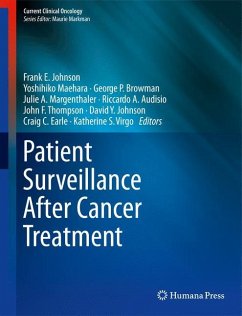Patient Surveillance After Cancer Treatment covers the history of cancer patient surveillance after curative-intent treatment, the rationale, the methodologies used in the past and at present, the methodologies that will probably emerge in the future, the costs of surveillance, the definitions of various terms used in the field, and how those who are interested in the topic can get more information about it from the internet. The secondary focus of the book is to publicize the need for well-designed, adequately powered randomized clinical trials comparing two (or more) surveillance strategies for each type of cancer.
The audience includes all oncologists, cancer researchers, medical economists and policy makers in government and insurance companies, and finally, interested patients.
This book is part of the Current Clinical Oncology series, which provides cutting-edge knowledge of cancer diagnosis, management, and treatment. World renowned experts share their insights in all the major fields of clinical oncology. From the fundamentals of pathophysiology to the latest developments in experimental and novel therapies, Current Clinical Oncology is an indispensable resource for today's practicing oncologist.
The audience includes all oncologists, cancer researchers, medical economists and policy makers in government and insurance companies, and finally, interested patients.
This book is part of the Current Clinical Oncology series, which provides cutting-edge knowledge of cancer diagnosis, management, and treatment. World renowned experts share their insights in all the major fields of clinical oncology. From the fundamentals of pathophysiology to the latest developments in experimental and novel therapies, Current Clinical Oncology is an indispensable resource for today's practicing oncologist.
From the reviews:
"This book discusses surveillance strategies for patients completing curative-intent primary treatment for cancer. ... Members of the oncology treatment team as well as primary care health professionals who provide post-treatment follow-up survivorship care will benefit from this informative, disease-specific resource. ... This is an extremely valuable and useful compilation of cancer site-specific surveillance guidelines for follow-up of asymptomatic patients who have completed primary treatment with curative intent." (Judith G. Abramson, Doody's Book Reviews, September, 2013)
"Patient Surveillance After Cancer Treatment is a well-written, well-organized reference designed to speak to any practicing oncologist or primary care provider that follows cancer patients after treatment for curative intent. ... This is a great text and reference to any clinically practicing oncologist, primary care provider, survivorship program, and training physician ofany level. Patient Surveillance After Cancer Treatment will continue to prove itself useful and will be readily available in our library." (Nima Nabavizadeh and David Elliott, Journal of Radiation Oncology, Vol. 2 (3), September, 2013)
"This book discusses surveillance strategies for patients completing curative-intent primary treatment for cancer. ... Members of the oncology treatment team as well as primary care health professionals who provide post-treatment follow-up survivorship care will benefit from this informative, disease-specific resource. ... This is an extremely valuable and useful compilation of cancer site-specific surveillance guidelines for follow-up of asymptomatic patients who have completed primary treatment with curative intent." (Judith G. Abramson, Doody's Book Reviews, September, 2013)
"Patient Surveillance After Cancer Treatment is a well-written, well-organized reference designed to speak to any practicing oncologist or primary care provider that follows cancer patients after treatment for curative intent. ... This is a great text and reference to any clinically practicing oncologist, primary care provider, survivorship program, and training physician ofany level. Patient Surveillance After Cancer Treatment will continue to prove itself useful and will be readily available in our library." (Nima Nabavizadeh and David Elliott, Journal of Radiation Oncology, Vol. 2 (3), September, 2013)








